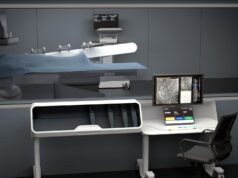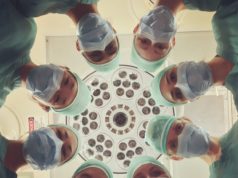 Ian Loftus talks to Vascular News about various aspects of his professional life, from a surgical placement that inspired his career path through to professorship at St George’s Hospital in London, UK. The current president of the Vascular Society of Great Britain and Ireland, Loftus talks us through what to expect at this year’s upcoming annual meeting, as well as giving his perspective on the biggest challenges currently facing vascular surgery.
Ian Loftus talks to Vascular News about various aspects of his professional life, from a surgical placement that inspired his career path through to professorship at St George’s Hospital in London, UK. The current president of the Vascular Society of Great Britain and Ireland, Loftus talks us through what to expect at this year’s upcoming annual meeting, as well as giving his perspective on the biggest challenges currently facing vascular surgery.
What led you to become a vascular surgeon?
I went to medical school with the ambition of following a career in primary care. But during my third year, on my first placement to a surgical team, I assisted in an appendicectomy with a very charismatic registrar. I immediately knew I wanted to be a surgeon.
My father died when I was 16 years old from complications after a carotid endarterectomy. During my second year at medical school my elder brother also died, as a consequence of a medical error. While initially making me question my future in medicine, ultimately these two events are what drove me to do what I do now. My ambition has always been to work to the very highest standards, providing the very best outcomes for vascular patients under my care, but also nationally, in an environment of complete transparency and integrity.
Who have been your professional mentors, and what lessons did you learn from them?
During my early training professor Peter Bell was the most influential mentor, but the whole team in Leicester, UK (Ross Naylor, Nick London, and Mark McCarthy in particular) supported me wholeheartedly. They gave me a huge amount of hands on training, backed up by supporting me with a programme of research. Peter Bell, the Professor of Surgery in Leicester, took me under his wing as a medical student and convinced me that I had the ability to succeed, especially when I doubted I would make it to the end of medical school. He gave me much needed confidence and was very much a father figure for me in the early years. From nearly failing my early preclinical years, I graduated with distinction and won the Leicester University prize for clinical excellence. As well as being an incredibly gifted surgeon and academic, professor Bell was also a great team player and family man. He treated everyone in the hospital the same, from the theatre porter to the chief executive.
In my years as a junior Consultant, Matt Thompson was my invaluable mentor. He is a truly great aortic surgeon, which combined with an enviable breadth of knowledge and balanced clinical opinion, is very rare in our speciality. He is the person who has shaped my career more than any. I will be indebted to him for the rest of my career, and beyond.
In the last year, which new paper presentation has caught your attention?
The paper on the long-term outcomes from the OVER trial, published in May 2019 (Lederle et al, New England Journal of Medicine 2019: 380; 2126–35). The publication from the EVAR trials in the UK have demonstrated less favourable outcomes for patients who underwent endovascular repair out to 15 years. This and other long-term trial data have been very influential in the conclusions of the draft NICE guidelines in England. However, the paper from the OVER trial was quite different, demonstrating an equivalent long-term survival but with trends towards better overall survival in the endovascular group and higher aneurysm related mortality in the open surgery group.
What have you achieved as president of the VSGBI?
On a positive note, I am very proud of the Quality Improvement Programme for patients with lower limb ischaemia. The Audit and Quality Improvement Committee of the Vascular Society under the auspices of Jonathon Boyle has produced an ambitious care pathway and timelines for the management of patients, especially for critical ischaemia, which is now the focus of a national Quality Improvement Programme. We are appointing two research fellows to assess the impact on outcomes across the country, jointly funded by the Circulation Foundation and the Royal College of Surgeons of England.
However, much of my period as President has been consumed with dealing with the controversies surrounding the draft NICE guidelines for the management of patients with aortic aneurysms, put out for a period of consultation in 2018. Until this is resolved to a satisfactory conclusion, it will be difficult to feel I have achieved enough. I, and the current Council of the Society, feel it is vital to the future of vascular services in the UK to have a more balanced approach to aortic aneurysm repair than the guidelines in their draft form would allow, incorporating patient choice and a personalised approach to treatment.
What do you look forward to at the upcoming VSGBI annual meeting?
The theme of the meeting is “A safe and sustainable vascular service for the future”. We have a tremendous programme of high-quality speakers. In the light of the controversies surrounding the long term aneurysm trial publications and the draft NICE guidelines, I am particularly looking forward to the Kinmonth lecture from Jan Blankenstein, entitled “The Current Status of EVAR- 2 decades of daydreams and nightmares”. We also have lectures from the guidelines director from NICE (Paul Chrisp) and the national lead for the “Getting it Right First Time” programme, professor Tim Briggs.
Of course, I hope that the NICE aneurysm guidelines will come to a satisfactory conclusion by then. It would be good to be able to address the members of our Society with an agreed and workable solution to what has been a very challenging issue for all concerned.
In your opinion, what are the biggest challenges currently facing vascular surgery?
Demonstrating that what we do is clinically- and cost-effective in the long term. As practice has shifted more to the endovascular approach, so we rely on technology to match our ambition. We have seen problems with the adoption and late failure of some of these technologies, and the draft NICE guidelines have challenged the cost-effectiveness of endovascular aneurysm repair more broadly. Other therapies may suffer the same fate.
We have to strive to demonstrate that what we do is always in the best interests of the patient, but also be conscious of the financial restraints of a tax-based healthcare system in the UK.
We must also overcome the inter-disciplinary frictions and anxieties that surround the endovascular work. Vascular specialists from whichever discipline, who are trained appropriately, should be able to perform all vascular interventions as long as they can demonstrate appropriate training, outcomes, and governance arrangements. To do so, they must be able to work in appropriately resourced and supported multi-disciplinary teams.
Could you tell us about one of your most memorable cases?
Probably the first ruptured aneurysm I treated with an endovascular approach stands out among many memorable cases during my career. I had become accustomed to patients languishing on intensive therapy units for days after open repair of a ruptured aneurysm, often returning to theatre for abdominal compartment syndrome or other complications, and taking many months to return to normal activity and daily function. Many years ago we convinced our hospital to install a hybrid theatre, fully stocked with everything required for an endovascular practice. I clearly remember my first patient who I treated under local anaesthetic with a stent graft for a ruptured infrarenal aneurysm, who later that day was sat up in bed having a cup of tea, chatting to his family. He was discharged a few days later and remains well with annual ultrasound surveillance to this day. This has become our unit standard practice and is the only clinical scenario where an endovascular approach is recommended within the draft NICE guidelines. I do not believe this could be achieved without an elective practice. I feel strongly that this would be a big step backwards for the profession.
How do you like to spend your time outside of work?
I have discovered cycling rather late in life but now take every opportunity to jump into lycra and hit the country lanes around that surround London. This year I completed an event for the Circulation Foundation charity called “The Ride 100” in just over five hours, a 100-mile circuit starting and finishing in central London. I am grateful for the support of my friends and colleagues in raising nearly £2000 for research into vascular disease.












